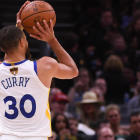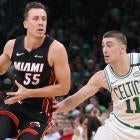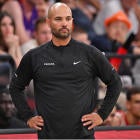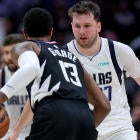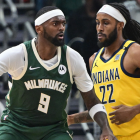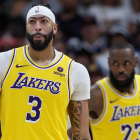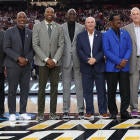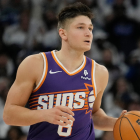Ranking professional basketball players is difficult, fraught with complications and, ultimately, reductive. Our top 100 list, then, is not meant to be definitive. Many decisions we made will frustrate you now, and many others will look laughable in the future. We fully accept, this, though, and did it anyway in an effort to capture what the league looks like heading into the 2018-19 season.
When weighing a trade or signing, executives often have to ask thorny questions about player value: Is this 3-and-D guy more helpful than this playmaking guard with defensive concerns? Will this 21-year-old center ever be able to anchor a defense? The answer might depend on who else is on the roster and how much confidence the organization has in its development program, but we can't take that stuff into account here. As best we could, we tried to evaluate everybody on his own merits and project how all of these players will perform this coming season. You can see the full CBS Sports Top 100 player rankings here as determined by NBA experts from CBS Sports and 247Sports and here are 20 takeaways from the rankings:
Don't sleep on Steph
How you rank Stephen Curry (No. 4) and Kevin Durant (No. 2) is a matter of perspective and taste. Steve Kerr himself has said that Durant is the better player by virtue of his unprecedented combination of size and skill. In the context of Kerr's team, though, Curry is more irreplaceable, as reflected by the on/off-court numbers and, simply, style. The Warriors don't look like the Warriors without Curry, a revolutionary player who last season quietly posted a career-high 67.5 percent true shooting percentage, the 16th-best mark in NBA history per Basketball-Reference and an absolutely absurd mark considering the degree of difficulty his shots would represent for anybody else. Presumably, Curry is listed lower than Anthony Davis (No. 3) here because he cannot dominate the same way on the defensive end, but it wouldn't be hard to make an argument that he should really be all the way at the top.
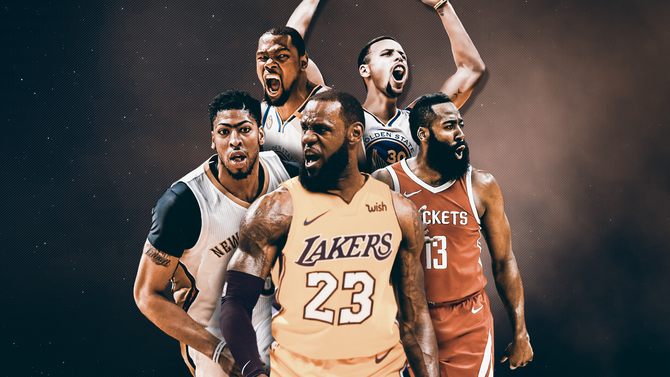
Imagine, for example, what we would be saying about Curry if Mark Jackson had stuck around for a few more years and he didn't become a megastar until this past season. Let's not take him for granted.
Is Leonard going to be the same guy in Toronto?
The last time Kawhi Leonard (No. 6) was healthy, he finished third in MVP voting and was considered the most dominant two-way force in the NBA. In 2016-17, the Spurs tilted their offense in his direction, allowing him to post a 31.1 percent usage rate and average a career-high 25.5 points. Then he missed all but nine games last season and forced his way out of San Antonio, raising questions about his priorities and the long-term health of his quad.
In a recent interview with ESPN's Adrian Wojnarowski, Masai Ujiri said he told Leonard that the Raptors believe he is a top-three player. If he is, then he could take this group to the NBA Finals. If not, then how far will he fall? As you can see on our list, there is quite a difference between the truly elite franchise players and, say, the 20th best player in the league. Collectively, we expect him to at least approximate his pre-injury production.
A contrast in everything: Westbrook and CP3
I'm not sure how to even begin comparing Russell Westbrook (No. 8) and Chris Paul (No. 9). I do find it kind of perfect, though, that they wound up right next to each other. While they can both be fiery in temperament, their approaches to the point guard position couldn't be more different. Where Paul is patient and surgical, Westbrook is relentless and, sometimes, reckless. Westbrook has now averaged a triple-double for two seasons in a row, but Paul led the whole league in real plus-minus last season and has a massive edge in shooting efficiency.
Swapping their coaches and teammates is a fascinating thought experiment. I'd love to hear James Harden's (or, soon, Carmelo Anthony's) honest thoughts on this one.
What kind of greatness do Thompson and Green possess?
One controversial outcome here: Klay Thompson (No. 15) is listed as the third-best Warrior, not Draymond Green (No. 18), as our panel collectively valued the former's all-time-great shooting more than the latter's all-time-great defense. (Full disclosure: I personally had Green ranked 10th and Thompson 18th). Everybody is going to have his or her own preferences here, and assessing their value compared to franchise players like Damian Lillard or John Wall is somewhere between challenging and futile.
One might argue that Thompson is overrated because he couldn't handle the playmaking responsibility of a lead guard, but Golden State would never trade him for an inferior shooter and defender who needs the ball in his hands. It is easy to say that the Warriors give Green an absolutely perfect environment for him to succeed, but it's not as if there is a single team on which he wouldn't fit. These rankings are only an attempt to untangle individual players from their team contexts. In the real world, that is impossible, and all we have is overwhelming evidence that these players affect winning in an enormous way.
Is KAT there yet?
It's worth repeating that this list is partially guesswork: we were asked to account for improvement and regression. In that respect, the case of Karl-Anthony Towns (No. 16) is worth examining. Offensively, his game is mature far beyond his 22 years -- this is one of the league's better post players, and he made 42 percent of his 3-pointers last season. Defensively, though, there is lots of room for improvement, and ESPN reported that tension between him and two-way star Jimmy Butler (No. 13) has much to do with the latter's uncertain future in Minnesota. If Towns is going to live up to this ranking, he must make significant strides as a defender and become the type of player Butler will not want to leave.
Betting on Booker?
Towns' buddy from Kentucky Devin Booker (No. 36) is in a lower tier but a similar predicament. In less than ideal circumstances, Booker has developed a well-rounded offensive game, averaging 24.9 points and 4.7 assists with pretty good efficiency last season. He's not yet a plus defender, though, and his beautiful shooting stroke suggests he should be able to hit the 40-percent mark from long range at some point. Many analysts are optimistic that will happen this year, as the Suns have tried to assemble a more competitive roster around him, but the fine folks at Sports Illustrated still ranked him No. 50 on their list.
For Booker, a breakout year wouldn't necessarily mean some sort of statistical explosion. He has to prove that he can make his teammates better and isn't an empty-stats guy. (It remains hilarious to me how polarizing he seems to be. Booker hasn't even turned 22 yet and his skill level is undeniable.)
Love, actually
The first time I took part in this exercise, before the 2014-15 season, we decided that Kevin Love (No. 36) was the fifth-best player in the NBA. It's a different league now, but this season will be the first since then where he has been his team's top offensive option. I'd love to see Cavaliers coach Tyronn Lue look back at Love's Minnesota tape and run some of the same stuff Rick Adelman did, taking full advantage of Love as a scorer, passer and floor spacer. The three players directly in front of him here (C.J. McCollum, Jayson Tatum and Jrue Holiday) are definitely not going to be the primary playmakers for their respective teams, and Love has a chance to show the world that he is capable of handling much more responsibility than he's had in Cleveland for the past few years.
Capela vs. Drummond
Players like Clint Capela (No. 41) tend to be underrated. His defense is more important to his team's success than his offense, and his greatest offensive attributes are screen-setting, vertical spacing and a crystal-clear understanding of his role. I would argue that Andre Drummond (No. 40), a two-time All-Star, has at times been held back by an inability or unwillingness to play like Capela in terms of giving multiple efforts on defense, rolling hard to the basket and accepting that post-ups are not where his bread is buttered. Drummond made progress in all these respects last season, though, and radically improved as a free-throw shooter and high-post facilitator.
The interesting part: We know exactly how Capela fits with the Rockets, while Drummond's partnership with Blake Griffin (No. 45) is very much a work in progress. Dwane Casey does not have an easy job.
Predicting the gripes: overrated Lakers
How much better will LeBron James (No. 1) make his new teammates? This question isn't as much about LeBron's ability as it is the overall strength of the Lakers' ecosystem and the young talent on the roster. Los Angeles fans might quibble with Rajon Rondo and Josh Hart being left off the list entirely, but I'm guessing there will be more pushback about how high Brandon Ingram (No. 53), Lonzo Ball (No. 72) and Kyle Kuzma (No. 81) are regarded here. I'd love to see Ingram become a high-volume 3-point shooter, Ball improve his percentages and Kuzma dedicate himself to defense, but James' presence doesn't guarantee that any of these things -- let alone all of them -- will happen.
Predicting the gripes: underrated Grizzlies, veteran stars, Gar Har
Mike Conley (No. 39) and Marc Gasol (No. 44) have the ability to make these rankings look silly if they stay healthy and lead the Grizzlies to the playoffs. Fans of other proven vets like Kyle Lowry (No. 37) and Paul Millsap (No. 46) will have more-than-reasonable complaints about where they wound up, considering the fact that they are great on both ends and that is not the case for some of the younger players ahead of them. Also, we have added fuel to the fire for those who believe Gary Harris (No. 52) is the most underrated player in the league -- he didn't even end up being the highest-rated Harris! (Tobias Harris finished one spot ahead of him.)
Zing!
Kristaps Porzingis (No. 26) is below some of his contemporaries like Towns, Ben Simmons (No. 19) and Nikola Jokic (No. 20), but this will still strike some as an overly generous projection because of his issues with durability, passing and perimeter defense. When he returns from his torn ACL, he will be expected to put the Knicks on his shoulders, but the 23-year-old still has a lot of development to do. An optimistic take: Porzingis can make a significant leap simply by reading the game more quickly, and it's possible that all these months of sitting out and watching film could be good for him in that regard. A shift to playing center full-time would be healthy, too.
Are we setting Mitchell and Tatum up to fail?
After Donovan Mitchell (No. 28) and Jayson Tatum (No. 33) captured our collective imagination with some amazing playoff performances, it is possible that we have gotten a bit carried away. They were insanely impressive in Year 1, but development is not linear and they are not bona fide stars yet. Will Mitchell learn from his inefficient series against Houston or did that matchup expose flaws that will take time to iron out? Can Tatum sustain his insane shooting while becoming more of a go-to-guy, or will Gordon Hayward and Kyrie Irving marginalize him? They both obviously have the talent to be elite players in the NBA, but don't freak out if it doesn't happen immediately.
Who is the best Celtic?
Depending on how you feel about Tatum and the up-and-coming Jaylen Brown (No. 42), one might argue that Boston is the only team that can match the Warriors in terms of having five All-Star-caliber players in the starting lineup. Beyond that, ranking the Celtics' three senior players -- Al Horford (No. 21), Kyrie Irving (No. 12) and Gordon Hayward (No. 24) -- is trickier than you'd think. If it's about creating offense out of thin air against elite defense, there is hardly anyone on the planet like Irving. If you value all the stuff coaches love -- intelligence, team defense, unselfishness, passing, leadership -- then Horford is your guy. Hayward represents a nice middle ground, if we are assuming that he plays like he did in Utah two seasons ago: medium-level usage for a star, plus top-notch defense and the ability to do all of his damage within the confines of a system.
What to make of this year's rookies?
These lists often don't feature rookies at all simply because it's so hard to have educated opinions about them. We decided to include them, and three -- Luka Doncic (No. 59), DeAndre Ayton (No. 74) and Marvin Bagley (No. 91) -- made the cut. Based on his unreal production for Real Madrid and the Slovenian national team, Doncic has earned his high expectations. The others are more questionable -- they were the top two picks in the draft, but that probably had more to do with upside than whatever we see them do this coming season. Personally, I would have gone with the two picks after Doncic -- Jaren Jackson and Trae Young -- before Ayton and Bagley, but I'm no scout.
The unpopular players who made it anyway
If you spend any time discussing basketball on the internet, you know that Andrew Wiggins (No. 69), Dwight Howard (No. 95) and Hassan Whiteside (No. 99) are not widely beloved. Wiggins still hasn't proved he's more than an empty-calorie scorer. Howard keeps managing to alienate himself and leave fired coaches and executives in his wake. Whiteside couldn't stay on the floor in the playoffs and his team was significantly better with Kelly Olynyk at center last season.
Wiggins is here primarily because he plays a ton of minutes, gets buckets and, at 23, still has potential. Howard is here because he can still add value as a rebounder and rim protector. Whiteside is here because his per-minute stats still look great and at least some of last season's struggles can be attributed to a knee injury. They will not be promised spots on next year's list because of their big names, however.
The Randle-Mirotic debate
One of my favorite small storylines for this upcoming season is the Pelicans' frontcourt. Nikola Mirotic (No. 79) was a godsend for the team last season, providing much-needed floor spacing and serving as a perfect partner for Anthony Davis. He is ranked lower than newcomer Juilus Randle (No. 76), however, and it'll be fascinating to see who starts games, who finishes them and how the chemistry works out. Randle can be tough to stop and he is coming off the best year of his young career, but if the goal is maximizing Davis then Mirotic might be the best man for the job.
Big year for Bledsoe
Eric Bledsoe (No. 58) wouldn't be on this list if we were just looking at how he played against the Celtics in the postseason. He was productive in the regular season, though, and he could earn himself a big payday if he gets along with new Bucks coach Mike Budenholzer. That will require him to play with consistent energy on defense, pick his spots offensively and buy into Budenholzer's system. This is where we must point out that, if he hijacks the offense, his effort waxes and wanes and he hurts Milwaukee's spacing, he could quickly find himself on the trade block again.
Buying the Turner hype
Myles Turner (No. 60) didn't have the year he wanted last season, but it looks like our staff is counting on him breaking out. It's an encouraging sign that he has gotten in better shape this summer, and we'll have to see how that translates, how well he shoots from long range and whether or not he and Domantas Sabonis can coexist in the frontcourt. The Pacers have the potential to be one of the better teams in the East if Turner makes a leap.
The 10 highest-paid players not on the list
Here are the names: Chandler Parsons ($24.1 million), Danilo Gallinari ($21.6 million), Ryan Anderson ($20.4 million), Jabari Parker ($20 million), Zach LaVine ($19.5 million), Tyler Johnson ($19.2 million), George Hill ($19 million), Wesley Matthews ($18.6 million), Joakim Noah ($18.5 million), Allen Crabbe ($18.5 million). The main thread here is injuries, but it's also kind of amazing that the Chicago Bulls signed two of them this summer. (Carmelo Anthony would have obviously been in this section if he hadn't agreed to a buyout.)
The best players not on the list
One of the most laborious parts of this whole thing is figuring out who gets the last 30 spots or so. How in the world do you compare an aging star like Dirk Nowitzki to a developing player like Dejounte Murray? I think both of those guys could have easily made the cut, and I'll add 10 more names: Kent Bazemore, Pascal Siakam, Kelly Olynyk, Montrezl Harrell, Justise Winslow, Malcolm Brogdon, Domantas Sabonis, James Johnson, Kyle Korver and Taurean Prince.













